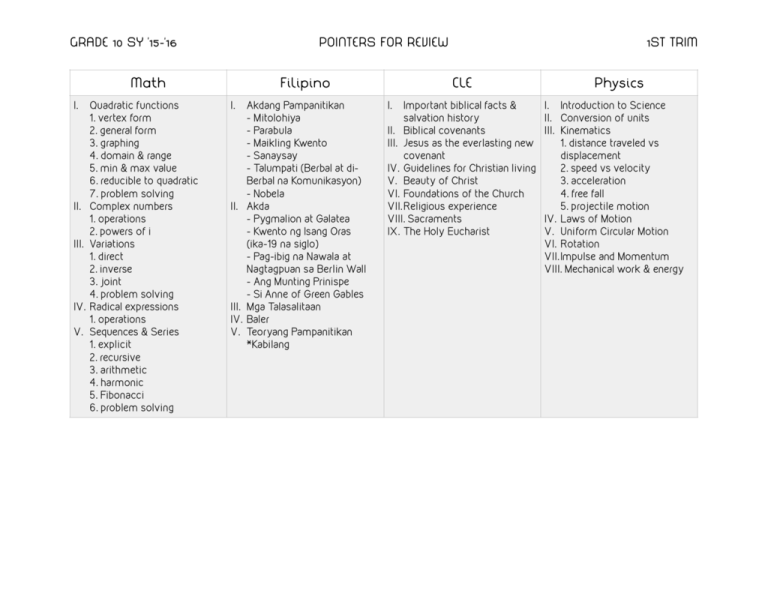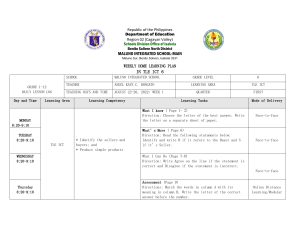grade 10 1st trim exam pointers
advertisement

GRADE 10 SY ’15-‘16 POINTERS FOR REVIEW Math I. II. III. IV. V. Quadratic functions 1. vertex form 2. general form 3. graphing 4. domain & range 5. min & max value 6. reducible to quadratic 7. problem solving Complex numbers 1. operations 2. powers of i Variations 1. direct 2. inverse 3. joint 4. problem solving Radical expressions 1. operations Sequences & Series 1. explicit 2. recursive 3. arithmetic 4. harmonic 5. Fibonacci 6. problem solving Filipino I. II. III. IV. V. Akdang Pampanitikan - Mitolohiya - Parabula - Maikling Kwento - Sanaysay - Talumpati (Berbal at diBerbal na Komunikasyon) - Nobela Akda - Pygmalion at Galatea - Kwento ng Isang Oras (ika-19 na siglo) - Pag-ibig na Nawala at Nagtagpuan sa Berlin Wall - Ang Munting Prinispe - Si Anne of Green Gables Mga Talasalitaan Baler Teoryang Pampanitikan *Kabilang 1ST TRIM CLE I. Important biblical facts & salvation history II. Biblical covenants III. Jesus as the everlasting new covenant IV. Guidelines for Christian living V. Beauty of Christ VI. Foundations of the Church VII. Religious experience VIII. Sacraments IX. The Holy Eucharist Physics I. Introduction to Science II. Conversion of units III. Kinematics 1. distance traveled vs displacement 2. speed vs velocity 3. acceleration 4. free fall 5. projectile motion IV. Laws of Motion V. Uniform Circular Motion VI. Rotation VII. Impulse and Momentum VIII. Mechanical work & energy GRADE 10 SY ’15-‘16 Economics Nature of Economics I. 1. Definition & scope of Economics 2. Economics as a Social Science & its relation to other Social Sciences II. 3. The importance of studying Economics III. II. Tools in Economic Thinking 1. Observation 2. Assumption 3. Variable 4. Theory 5. Models III. Economic Concepts 1. Scarcity 2. Needs and Wants 3. Choice 4. Opportunity costs 5. Trade offs IV. Production 1. Factors of Production 2. Production Possibilities Frontier (PPF/C) 3. Stages of Production 4. Diminishing Marginal Returns 5. Production Input 6. Production Costs 7. Production Revenue 8. Profits & Loss 9. Break-even point 10. Optimum Level of Production I. POINTERS FOR REVIEW Music Impressionism 1. Visual arts 2. Musical features & characteristics 3. Claude Debussy Post-Impressionism 1. Igor Stravinsky Expressionism 1. Visual arts 2. Musical features & characteristics 3. Arnold Schoenberg English I. Literature A. Beowulf B. The Iliad C. Sonnet 116 and 43 (How Do I Love Thee? D. Cask of Amontillado E. Success is Counted Sweetest F. The Gettysburg Address G. Vocabulary Words H. Formalism I. 5 Basic Conventions of an Epic J. Figures of Speech II. Writing A. Essay (Parts, ComparisonContrast, Procedural) B. APA Citation (For Books and Electronic Devices) C. Subject-Verb Agreement 1ST TRIM Schedule TUESDAY • 7:40-10:00 - HR/Mass • 10-11:30 - Math • 10-12 - MEP (CAI room) • 11:30-12:30 - IW WEDNESDAY 7:40-7:50 - HR • • 7:50-9:20 - Filipino • 9:20-9:40 - Recess • 9:40-11:10 - CLE • 11:30-1:30 AP World THURSDAY • 7:40-7:50 - HR • 7:50-9:20 - Science • 9:20-9:40 - Recess • 9:40-11:10 - Econ • 11:10-12:10 - Music FRIDAY 7:40 - 7:50 - HR • • 7:50 - 9:20 - English • 9:20-9:40 - Recess • 9:40-12:10 - IW










